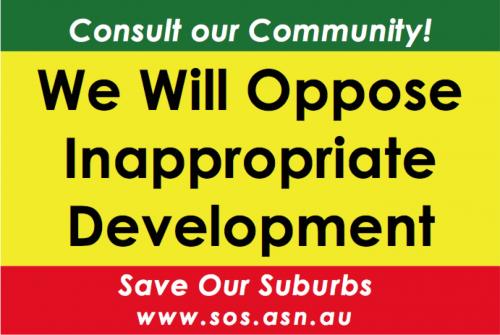SOS Media Release, 27 April 2012
Some current media reports suggest that Councils pushing ahead with higher density housing along public transport routes are flouting Coalition Government planning policy.
However, when it won office in 2010 the Baillieu Government did not dump the unpopular Labor policy that encouraged high-density development along transport corridors, despite claims to the contrary by Planning Minister Matthew Guy.
Planning amendment VC75 (gazetted 16th December 2010) was touted by the minister as reversing the most controversial planning changes introduced 3 months earlier by former Minister Madden.
The Departmental Explanatory Report stated that VC75 "removes reference to locate new housing along tram, train, light rail and bus routes and around train stations from Clause 16.01-3."
"But that sentence is still there!', said Ian Wood, president of community group Save our Suburbs.
"Apart from deleting the reference to stations, the only change was to replace the word 'along' with 'on or abutting'". (*See below)
"Clause 16.01-3 is all about strategic high density development sites. So this clause will continue to encourage large-scale development all along major public transport routes".
"In fact, removing the reference to stations from clauses 16.01-3 and 16.01-2 will make traffic congestion worse – at least if high-density was focused around stations, more of these residents could use trains".
There are also other similar references to intensification in clause 16, all still underpinned by Melbourne 2030.
"So unless the government modifies or removes all these references as the community has demanded, state government planning policy will still encourage carte-blanche high density development all along public transport corridors".
ENDS
For more information:
Ian Wood, President, Save Our Suburbs
* To confirm the wording of Cl.16.01-3, go to <http://planningschemes.dpcd.vic.gov.au/index.html>, select any planning scheme, then choose "16 Housing" from the drop-down menu under "10 State Planning Policy Framework"
– – – – – – –
DETAILED EXPLANATION:
CHANGES TO CLAUSE 16.01-2 " Location of residential development"
20/09/2010 Amendment VC71 (Madden)
[sections underlined were deleted in the later amendment VC75 by Minister Guy]
16.01-2 Location of residential development
Objective
To locate new housing in or close to activity centres and employment corridors and at other
strategic redevelopment sites that offer good access to services and transport.
Strategies
– Increase the proportion of housing in Metropolitan Melbourne to be developed within the
established urban area, particularly at activity centres, employment corridors and at other
strategic sites, and reduce the share of new dwellings in greenfield and dispersed
development areas.
– In Metropolitan Melbourne, locate more intense housing development in and around
activity centres, in areas close to train stations and on large redevelopment sites.
– Encourage higher density housing development on sites that are well located in relation to
activity centres, employment corridors and public transport.
– Ensure an adequate supply of redevelopment opportunities within the established urban
area to reduce the pressure for fringe development.
– Facilitate residential development that is cost-effective in infrastructure provision and use,
energy efficient, incorporates water efficient design principles and encourages public
transport use.
– Identify opportunities for increased residential densities to help consolidate urban areas.
Policy guidelines
Planning must consider as relevant:
§ Melbourne 2030 (Department of Sustainability and Environment, 2002).
§ Melbourne 2030: A planning update Melbourne @ 5 million (Department of Planning
and Community Development, 2008).
16/12/2010 Amendment VC75 (Guy)
16.01-2 Location of residential development
Objective
To locate new housing in or close to activity centres and employment corridors and at other
strategic redevelopment sites that offer good access to services and transport.
Strategies
– Increase the proportion of housing in Metropolitan Melbourne to be developed within the
established urban area, particularly at activity centres, employment corridors and at other
strategic sites, and reduce the share of new dwellings in greenfield and dispersed
development areas.
– Encourage higher density housing development on sites that are well located in relation to
activity centres, employment corridors and public transport.
– Ensure an adequate supply of redevelopment opportunities within the established urban
area to reduce the pressure for fringe development.
– Facilitate residential development that is cost-effective in infrastructure provision and use,
energy efficient, incorporates water efficient design principles and encourages public
transport use.
– Identify opportunities for increased residential densities to help consolidate urban areas.
Policy guidelines
Planning must consider as relevant:
§ Melbourne 2030 (Department of Sustainability and Environment, 2002).
– –
CHANGES TO CLAUSE 16.01-3 "Strategic redevelopment sites"
20/09/2010 Amendment VC71 [Madden]
[sections underlined were changed or deleted in the later amendment VC75]
16.01-3 Strategic redevelopment sites
Objective
To identify strategic redevelopment sites for large residential development in Metropolitan
Melbourne.
Strategies
Identify strategic redevelopment sites that are:
§ In and around Central Activities Districts.
§ In or within easy walking distance of Principal or Major Activity Centres.
§ In or beside Neighbourhood Activity Centres that are served by public transport.
§ Along tram, train, light rail and bus routes that are part of the Principal Public Transport
Network and close to employment corridors, Central Activities Districts, Principal or
Major Activity Centres and around train stations.
§ In or near major modal public transport interchanges that are not in Principal or Major
Activity Centres.
§ Able to provide 10 or more dwelling units, close to activity centres and well served by
public transport.
Policy guidelines
Planning must consider as relevant:
§ Melbourne 2030 (Department of Sustainability and Environment, 2002).
§ Melbourne 2030: A planning update Melbourne @ 5 million (Department of Planning
and Community Development, 2008).
16/12/2010 Amendment VC75 [Guy]
16.01-3 Strategic redevelopment sites
Objective
To identify strategic redevelopment sites for large residential development in Metropolitan
Melbourne.
Strategies
Identify strategic redevelopment sites that are:
§ In and around Central Activities Districts.
§ In or within easy walking distance of Principal or Major Activity Centres.
§ In or beside Neighbourhood Activity Centres that are served by public transport.
§ On or abutting tram, train, light rail and bus routes that are part of the Principal Public
Transport Network and close to employment corridors, Central Activities Districts,
Principal or Major Activity Centres.
§ In or near major modal public transport interchanges that are not in Principal or Major
Activity Centres.
§ Able to provide 10 or more dwelling units, close to activity centres and well served by
public transport.
Policy guidelines
Planning must consider as relevant:
§ Melbourne 2030 (Department of Sustainability and Environment, 2002).
– – –
AMENDMENT VC75: EXPLANATORY REPORT BY DPCD
(DEPARTMENT OF PLANNING & COMMUNITY DEVELOPMENT)
What the amendment does
The amendment amends Clause 16 – Housing of the State Planning Policy Framework (SPPF) by removing Melbourne @ 5 Million policies relating to intensive housing development along public transport corridors and around train stations from the clause.
In particular, the amendment removes reference to locate, in Metropolitan Melbourne, more intense housing development in an around activity centres, in areas close to train stations and on large redevelopment sites from Clause 16.01-2 and to locate new housing along tram, train, light rail and bus routes and around train stations from Clause 16.01-3.
The amendment also removes Melbourne 2030: A planning update Melbourne @ 5 Million (DPCD 2008) as a document listed under Policy guidelines in Clause 16.
————————————-
Note: while the key part of Clause 16.01-2 was deleted by VC75 (unlike the sentence referred to in 16.01-3), the very next point of 16.01-2 covers similar issues and still remains part of the clause:
Deleted sentence:
– In Metropolitan Melbourne, locate more intense housing development in and around
activity centres, in areas close to train stations and on large redevelopment sites.
Retained sentence:
– Encourage higher density housing development on sites that are well located in relation to
activity centres, employment corridors and public transport.


